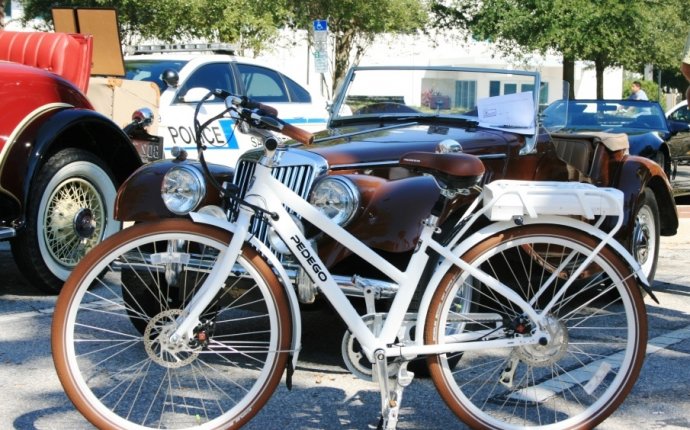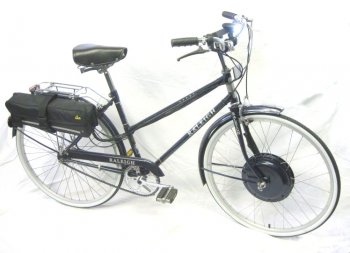
Electric Bicycle Homemade
 Electric bikes are a new and promising alternative form of urban transportation. They provide all the advantages of a regular bicycle: fun exercise, free parking, zero emissions, and freedom from gridlock, while eliminating one of the bicycle's more serious drawbacks, lack of power. Imagine pedalling up a hill as comfortably as riding down, that's what the e-bike experience is all about. In most situations in the city, riding an electric bike will be faster and cheaper than either car or public transit.
Electric bikes are a new and promising alternative form of urban transportation. They provide all the advantages of a regular bicycle: fun exercise, free parking, zero emissions, and freedom from gridlock, while eliminating one of the bicycle's more serious drawbacks, lack of power. Imagine pedalling up a hill as comfortably as riding down, that's what the e-bike experience is all about. In most situations in the city, riding an electric bike will be faster and cheaper than either car or public transit.
Fundamentally, an e-bike is just a regular bicycle with an electric motor to provide additional assistance. You can pedal normally and just use the motor to help out on hills and headwinds, or use the motor all the time just to make riding easier. The experience is entirely different from riding say a gas scooter or motorbike. Here the electric assistance is perfectly smooth and silent, and it complements rather than supplants human power.
Are they road legal in Canada?
Yes, the Motor Vehicle Act was recently modified to include a class of Power Assisted Bicycles. In BC the rules state that with continuous motor power under 500 watts, and at speeds less than 32 km/h, there is no need for either a license or insurance to use an electric bike on public roads.
In the past several years, many countries have adopted some kind of legislation to legitimize electric bicycles on the roadways or are in the process of doing so. In many of these jurisdictions, the limitations are quite a bit more restrictive, with 20 or 25 km/h maximum speeds and power limits of just 200 or 250 watts. For fit cyclists or people who are seriously considering ebikes to be their primary vehicle, these conservative regulations can have the effect of hindering the adoption of what is indisputably among the greenest and most convenient transportation modes to come around.
Won't the extra weight make it difficult to pedal without the motor?
The short answer is yes but not much. The effect of weight is largely exaggerated in how a bicycle performs. People spend thousands to shave off a few pounds for a really high-end bike. But since the rider is already at least 5-6 times heavier than the bike, the vehicle weight itself makes minimal difference. A heavier bicycle is slightly harder to ride uphill, somewhat faster to ride downhill, and pretty much the same on the flat as a lightweight one.
The addition of a motor and batteries can add anywhere from 20 to 40 lb to a bike and has surpisingly little effect on its rideability. My university textbooks weigh a comparable amount and aren't nearly so helpful on the road. You definitely do notice the weight if you have to pick the bike up and carry it for any reason though, and it can be a bit unwieldy.
Now those 20-40 lbs of additional weight are more than made up for in their hauling capacity on even the steepest of hills, and trip times with an ebike are usually between 20-30% faster than a regular bicycle.
How much power does it use?
The average power that a typical cyclist will deliver is on the order of 150 watts, or 1/5th of a horsepower. If you're curious, most modern exercise bikes will display the exact wattage and you can get a feel for how much power you're producing with the legs. A fit individual can sustain 350 watts for about 10 minutes and up to 600 watts for a few seconds, but for continuous riding between 100-200 watts is typical. You might think then that 150 watts would be all you need for an ebike, but if you ever ride a 150 watt bike it will feel unimpressive. When a cyclists hits a hill, they switch to an easy gear and the speed drops to 10-15 km/h as they work hard and move at a slow pace. However when an electric bike does the same thing and slows to walking speed on the hills it seems way under powered. To maintain nice speeds over 30 kph while going uphill requires on the order of 400-500 watts or more. On the flat, 400 watts (about 1/2 horsepower) will move a typical bicycle about 40 km/h.
For comparison, car engines are usually several hundred horsepower, and travel at a comparable average speed in the city, and only twice as fast outside.
Does it recharge the batteries while you pedal?
For some reason this is one of the most commonly asked technical questions we get and it shows that the advantages and capabilities of electric drives are widely known. The answer is that yes, on most hub motor ebikes it is possible to recharge the batteries from pedaling. BUT, only when you are moving at a speed faster than the motor can attain itself.
Recharging from pedaling is not really the intent of the electric drive as it is with, say, a hybrid car. In general, with an ebike you draw a net amount of power out of the battery pack to assist you riding. You then replenish this energy from the wall outlet, rather than by working extra hard later on in the trip. BionX is the only ebike kit I am aware of that has a specific regen mode that allows you to work against the motor and recharge the batteries continuously while riding at lower speeds. Its like hauling a heavy trailer with two flat tires, so unless you're in it for the exercise alone there is little point.
The topic of regenerative braking comes up quite frequently, and the point here is not to recharge the batteries from your pedaling energy, but to recharge them from stored kinetic energy when you come to a stop. With any direct drive hub motor or geared ebike without a freewheeling motor, you will get regen currents when you are moving faster than the unloaded speed of the motor. So even though it won't bring you to a stop, it does act as a speed governer of sorts for long downhills, dumping the extra energy back into the pack, whether you want it to or not. In most cases it's quite rare that you would actually achieve speed greater than the unloaded speed of the motor for any length of time.
In order to use regenerative braking to come to a stop, then you need a 2-quadrant motor controller and a drive train without a freewheel. This saves wear on the brake pads, and extends the range of the battery pack by 5-10% with no penalty. The controllers that come with TidalForce and BionX ebikes can do this. With Wilderness Energy, Golden Motors, Crystalyte, and similar chinese hub motor kits, it generally requires a 3rd party motor controller. Most chain or gear driven ebikes, like the Lashout, Heinzmann, and Currie, have freewheeling clutches that make regenerative braking impossible.









